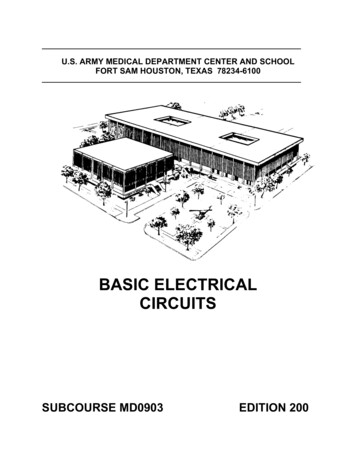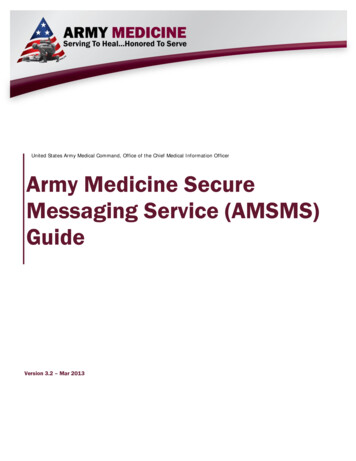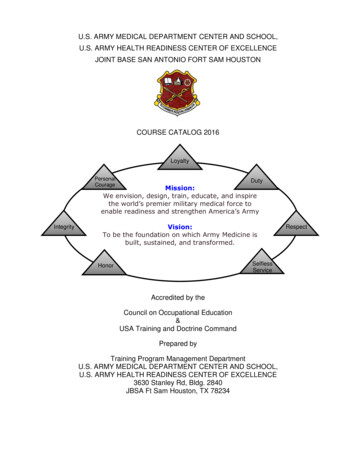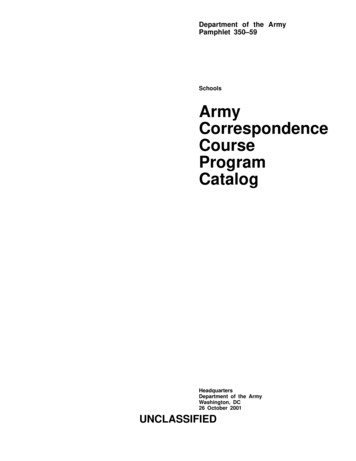
Transcription
U.S. ARMY MEDICAL DEPARTMENT CENTER AND SCHOOLFORT SAM HOUSTON, TEXAS 78234-6100BASIC ELECTRICALCIRCUITSSUBCOURSE MD0903EDITION 200
DEVELOPMENTThis subcourse is approved for resident and correspondence course instruction. Itreflects the current thought of the Academy of Health Sciences and conforms to printedDepartment of the Army doctrine as closely as currently possible. Development andprogress render such doctrine continuously subject to change.ADMINISTRATIONFor comments or questions regarding enrollment, student records, or shipments,contact the Nonresident Instruction Section at DSN 471-5877, commercial (210) 2215877, toll-free 1-800-344-2380; fax: 210-221-4012 or DSN 471-4012, e-mailaccp@amedd.army.mil, or write to:COMMANDERAMEDDC&SATTN MCCS HSN2105 11TH STREET SUITE 4192FORT SAM HOUSTON TX 78234-5064Approved students whose enrollments remain in good standing may apply to theNonresident Instruction Section for subsequent courses by telephone, letter, or e-mail.Be sure your social security number is on all correspondence sent to the Academy ofHealth Sciences.CLARIFICATION OF TRAINING LITERATURE TERMINOLOGYWhen used in this publication, words such as "he," "him," "his," and "men" are intendedto include both the masculine and feminine genders, unless specifically stated otherwiseor when obvious in context.
TABLE OF CONTENTSLessonPAGEINTRODUCTION.1BASIC ELECTRICAL CIRCUITS.MD0903i1
CORRESPONDENCE COURSE OFTHE US ARMY MEDICAL DEPARTMENT CENTER AND SCHOOLSUBCOURSE MDO903BASIC ELECTRICAL CIRCUITSINTRODUCTIONThis subcourse is designed to give you a basic knowledge of simple circuitsthat carry electricity from a power source to some kind of electrical equipment. With aknowledge of these fundamentals, you will be able to make better use of electricalequipment and to better understand future textual materials that mention electricalfactors in the function of equipment.Subcourse Components:This subcourse consists of programmed text.Lesson 1. Basic Electrical CircuitsStudy Suggestions:Here are some suggestions that may be helpful to you in completing thissubcourse:--Read and study each lesson carefully.--Complete the subcourse lesson.Credit Awarded:To receive credit hours, you must be officially enrolled and complete anexamination furnished by the Nonresident Instruction Section at Fort Sam Houston,Texas. Upon successful completion of the examination for this subcourse, you will beawarded 3 credit hours.You can enroll by going to the web site http://atrrs.army.mil and enrolling under"Self Development" (School Code 555).A listing of correspondence courses and subcourses available through theNonresident Instruction Section is found in Chapter 4 of DA Pamphlet 350-59, ArmyCorrespondence Course Program Catalog. The DA PAM is available at the followingwebsite: 903ii
SUBCOURSE MD0903LESSON 1Basic Electrical Circuits.ASSIGNMENTFrames 1 through 100.OBJECTIVEAfter completing the programmed text, you should beable to choose correct answers to questions aboutbasic electrical circuits, current, resistance, amperes,volts, and equivalent.INSTRUCTIONSThis text is set up differently from most subcoursesIt is a workbook that utilizes programmed instruction.The numbered "frames" present information and/ora question about presented information. You shouldwork through the frames in the order presented.Answer each question that is presented. To checkyour answers, go to the shaded box of the NEXTframe. For example. the solution to the questionpresented in Frame 2 is found in the shaded box ofFrame 3.SUGGESTIONSRead Subcourse MD0902, Basic Electricity, beforetaking this subourse.After going through the programmed text at a relativelyslow pace, go back through it several times as rapidlyas you can. This will not take long and will help youfeel more knowledgeable as you study. The purpose ofthe programmed text is memorization as well asunderstanding.MD09031-1
FRAME 1The diagram below will help you to recall that current is aflow of through a conductor.FRAME 2Solution to Frame 1Below are several series circuits. Study the carefully.electronsIn a series circuit, there (is only one/are more than one) pathfor the current to flow.Solution to Frame 2FRAME 3is only oneThe above is a series circuit because.FRAME 4Solution to Frame 3Label each circuit as either “Series” or “Not Series.”a.b.c.d.it has only one path forcurrent to flowMD09031-2
FRAME 5Solution to Frame 4What would be the reading on the ammeter in the seriescircuit below?I E Ra. Seriesb. Not Seriesc. Not Seriesd. SeriesFRAME 6Solution to Frame 5No matter where you measure the current in the seriescircuit below, the current readings would all be the.12v 6 amp2ΩFRAME 7Solution to Frame 6In any part of a series circuit, the current is theas long as the circuit is not changed.same (6 amp)FRAME 8Solution to Frame 7Write in the current reading of each ammeter connected inthe series circuit below.samea.MD0903b.1-3
FRAME 9Solution to Frame 8In any series circuit, the total resistance (Rt) is the sum (ortotal) of all the single resistances. In the series circuit below,Rt is the of R1 and R2.a. 1 ampFRAME 10Solution to Frame 9a. The total resistance (Rt) in the series circuit below is10 Ω 40 Ω Ω.sum (or total)b. 1.ampb. Total resistance (Rt) is ohms.FRAME 11Solution to Frame 10In the series circuit belowa. 5b. 55R1 R2 R3 R4 The total resistance (Rt) is .MD09031-4
FRAME 12Solution to Frame 11So far, you have learned that in series circuits:R1 3 ΩR2 2 ΩR3 5 ΩR4 10 Ω(Rt) 20 Ωa. There is (only one/more than one) path for the current toflow.b. Current has (the same value/different values) everywherein the circuit.c. To get Rt (total resistance), we (add/subtract/multiply) allthe individual resistances.FRAME 13Solution to Frame 12To find It (current in any series circuit), you must use Rt inthe formula It EtRta. only oneb. the same valuec. addTo find It in the circuit above, you must use in theformula .FRAME 14Solution to Frame 13To find I in the series circuit below, you must use(10/20/30/200) Ω in the formula It EtRtRtMD09031-5It EtRt
FRAME 15Solution to Frame 14In a series circuit with only one resistor, R1 and Rt must bethe same. In the series circuit below, there is only oneresistor. This means the R1 and Rt (are/are not) the same.They are both equal to .30FRAME 16Solution to Frame 15To find the current in the circuit below, you would substitutethe number (4/6/10/24) for Rt in the formula It Et .RtareFRAME 17Solution to Frame 16In the circuit below, Et . Rt .10Find the current It .MD09031-62Ω
FRAME 18Solution to Frame 17If you calculated current (I) in the circuit below and used thisformula:90va.It Et, your answer would be (right/wrong).R1b.It Et, your answer would be (right/wrong).R2c.It Et, your answer would be (right/wrong).Rt30Ω3 ampIt Et 90v 3 ampRt 30ΩFRAME 19Solution to Frame 18In the circuit below, find I.a. wrongExample:b. wrong:c. rightIt Et 10 vRt (2 3) Ω 10v 2 amps5ΩYou do this one: MD09031-7
FRAME 20Solution to Frame 19In the circuit below, It .It Et 12 v 2 ampsRt6ΩFRAME 21Solution to Frame 20So far, you have learned that in series circuits:3 ampa. There is/are (only one/more than one) path for thecurrent to flow.It EtRt 90 v30 Ωb. Current has the (same/different) value everywhere in thecircuit. 3 ampc. To get Rt, we (sum/subtract) all individual resistances.d. To find It, you must use (R1/Rt) in the formulaIt Et .Rt.FRAME 22Solution to Frame 21The voltage applied by a battery is called the applied voltagea. only one(Ea).b. same.This battery will apply a voltage called the.c. sumFRAME 23Solution to Frame 22In the circuit below, the Ea (applied voltage) is volts.applied voltage (Ea)MD09031-8d. Rt
FRAME 24Solution to Frame 23To move a wagon uphill, you must apply a force. To moveelectrons through a resistor, a battery must also apply.24FRAME 25Solution to Frame 24When you move a wagon uphill, force is used up. Whenelectrons are pushed through a resistance, electromotiveforce (EMF) is also .a force (or a voltage)FRAME 26Solution to Frame 25When EMF is used up, the voltage drops. Across anyresistance, EMF is used up and the voltage .used upFRAME 27Solution to Frame 26The drop in voltage is called voltage drop.dropsAcross the resistor above, we have a 10v .FRAME 28Solution to Frame 27In the diagram below, the voltage drop across R1 isand across R2, it is .voltage dropMD09031-9
FRAME 29Solution to Frame 28You have learned that the symbol for voltage is E.(R1) 5vFor voltage drop across R1, you will use the symbol E1.(R2) 20vFor voltage drop across R2, you will use the symbol E2.For voltage drop across R3, you will use the symbol .FRAME 30Solution to Frame 29Total voltage drop (Et) is the sum of all individual voltagedrops. In the circuit below, Et is the ofE1 and E2. Et .E3FRAME 31Solution to Frame 30Et (total voltage drop) in this circuit is volts.total (or sum)15vMD09031-10
FRAME 32Solution to Frame 31Et in the circuit below is .30FRAME 33Solution to Frame 32Et (total voltage drop) in the circuit below is .15vEt (applied voltage) is also .FRAME 34Solution to Frame 33In the series circuit below, the Ea (applied voltage) is ,and the Et (total voltage) is . Et and Ea are(the same/different) in any series circuit.10vMD09031-1110v
FRAME 35Solution to Frame 34Et in the circuit below is ; Ea is .18v18vthe sameFRAME 36Solution to Frame 356vIf Et 24v, then Ea 6vIf Ea 6v then Et 6vIf any series circuit, Et and Ea are .FRAME 37Solution to Frame 36One way to find I (current) in a series circuit is to use Et inthe formula It EtRt24v6vthe same (equal)To find It in the circuit above, use in the formula.MD09031-12
FRAME 38Solution to Frame 37Find I in the circuit below.EtExample:You work this problem.It Et RtIt 20v10ΩIt 2 ampsIt EtRt It FRAME 39Solution to Frame 38Find I in the circuit below.EtRtExample:You do this:24v12Ω2 ampIt Et RtIt 27v9Ω 3 ampsMD0903It 1-13
FRAME 40Solution to Frame 39I (current) in the series circuit below is .It EtRt 5v5Ω 1 ampFRAME 41Solution to Frame 40You just learned that to find I in a series circuit, you use theformula: It Et.Rt3 ampSince Ea Et, you (may/may not)also use the formula9v3Ω 3 ampIt EaRtSolution to Frame 41FRAME 42In the circuit below I . mayMD09031-14
FRAME 43Solution to Frame 42Find I in the circuit below:3 ampI Ea 27v 3 ampRt 9Ωdrop at side resistor 12 v.drop at bottom resistor 9vFRAME 44Solution to Frame 43So far you have learned that in a series circuit:8 ampa. There is/are (only one/more than one) path for the currentto flow.It Et 80v 8 ampRt 10Ωb. I (current) has (the same/a different) value(s) everywherein the circuitc. To get Rt, you (sum/subtract) the individual voltageresistances.d. To get Et, you (sum/subtract) the individual voltage drops.e. Et and Ea (are/are not) the same.f. To find I, you (must/must not) use Rt.g. To find I, you (must/must not) use either Et or Ea.FRAME 45Solution to Frame 44The statement “The greater the resistance, the greater thevoltage drop” does not tell you how to calculate the exactvoltage drop. However, Ohm’s law does allow you to.a. only oneb. the samec. sumd. sume. aref. mustg. mustMD09031-15
FRAME 46Solution to Frame 45To calculate E (voltage drop across R1) exactly, you use theformula E1 I1 x R1:calculate the exactvoltage dropTo calculate E1 in the circuit above, you use the formula.FRAME 47Solution to Frame 46Find E1 in the circuits below:E1 I1 x R1Example:You do this oneE1 I x R1E1 3 amp x 2Ω 6v MD09031-16
Solution to Frame 47FRAME 48Example:E2 I x R2You do this one:E2 3 amp x 4Ω 12v E1 I1 x R1 4 amp x 6Ω 24vFRAME 49Solution to Frame 48In the circuit below I 2 amp. Find E2 (voltage drop acrossR2).E2 I x R2E2 . 3 amp x 5Ω 15vFRAME 50Solution to Frame 49Compute E2 in the circuit below: E2 .24vE2 I x R2 2 amp x 12Ω 24vMD09031-17
FRAME 51Solution to Frame 50To check the total voltage drops, you can sum the individualvoltage drops to get Et. This should equal Ea.E2 I x R2 4 amp x 10Ω 40vThe voltage drops calculated above (do/do not) check.FRAME 52Solution to Frame 51In the circuit below, find E1, E2, E3.E1 E2 doE3 Et FRAME 53Solution to Frame 52Sometimes you will not be told the value of I (current).Therefore, before you can compute E1, or E2, or E3, youmust find the value of to use in theformulas:E1 20vE2 24vE3 14vEt 58vE1 I1 x R2E2 x R2E3 MD09031-18
FRAME 54Solution to Frame 53To find E1 in the circuit below, you must first find. You find I now. I amp.II2I3 x R3FRAME 55Solution to Frame 54In the circuit below, find I and then E2.Total resistanceI ampE2 vEa 18v Rt 6ΩFRAME 56Solution to Frame 55In the circuit below, find I, E1, E2, and E3. I I Ea 24v 2 ampRt 12ΩE2 I x R2E1 E2 E3 2 amp x 4Ω 8vMD09033 amp1-19
FRAME 57Solution to Frame 56In the circuit below, find: E1 ; E2 ; E3 .Check: .2 amps (Rt 7 4 3 14ΩI Ea 28 2 ampsRt 14E1 I x R1 2 amp x7Ω 14vE2 I x R2 2 amp x4Ω 8vE3 I x R3 2 amp x3Ω 6vYes, 28v 28vSolution to Frame 57FRAME 58To summarize what you have learned about series circuits,complete the statements below:a. There is/are (only one/more than one) path for current toflow.b. I (current) has (the same/a different) value(s) everywherein the circuit.E1 20vE2 12vE3 8vCheck:Ea Et40v 40vc. To get Rt, you (sum/subtract) the individual resistances.d. To get Et, you (sum/subtract) the individual voltage drops.e. Et and Ea (are/are not) the same.f. To find I, you (must/must not) use Rt.g. To find I, you (must/must not) use Et or Ea.h. To find E1, use the formulai. To find E3, use the formula .MD09031-20
Solution to Frame 58FRAME 59This is one way of placingresistors in parallel.This is another way ofplacing resistors inparallel.Both of the above circuits are circuits.a. only oneb. the samec. sumd. sume. aref. mustg. musth. E1 I x R1i. E3 I x R3FRAME 60Solution to Frame 59These are all parallel circuits. The arrows show the paths ofcurrent flow.parallelA parallel circuit has (only one/more than one) path forcurrent flow.FRAME 61Solution to Frame 60The circuit below is broken at point A. Current still flowsbecause parallel circuit have (only one/more than one) pathfor current flow.more than oneFRAME 62Solution to Frame 61Label each circuit as either “parallel” or “series.”a.b.c.MD09031-21more than oned.
FRAME 63Solution to Frame 62Now let us look at resistance. In the parallel circuit below,a. Seriesresistance 1 (R1) is 15Ω; R2 is Ω; and R3 isΩ.b. Parallelc. Seriesd. ParallelFRAME 64Solution to Frame 63In any parallel circuit, Rt (total resistance) is less than thesmallest resistance. In the circuit below, Rt is less thanΩ.10FRAME 65Solution to Frame 64Rt will be less than 10Ω in the circuit below. Rt is always(more/less) than the smallest resistance.5FRAME 66Solution to Frame 65So far you have learned that:lessa. A parallel circuit has (only one/more than one) path forcurrent flow.b. Rt is (more/less) than the (largest/smallest) resistance ina parallel circuit.MD09031-2220
FRAME 67Solution to Frame 66To determine the value of Rt in a parallel circuit, use theformula:a. more than oneRt b. less; smallest11 1 1 , etc.R1 R2 R3In the circuit above, you use the formula Rt .FRAME 68Solution to Frame 67Find RtRt ExampleProblemRt R 11 1 1R1 R2 R311 1 1R1 R2 R3 11 1 136 12 1 1 124 2 17 712 12 1212 1.714 ΩMD09031-2311 1 1R1 R2 R3
FRAME 69Solution to Frame 68a. In the parallel circuit below, Rt equals .b. Rt (is/is not) less than the smallest resistor.Rt 11 1 12 4 814 2 188 8 1 8778FRAME 70 1.14ΩSolution to Frame 69So far you have learned that:a. Rt 11 1 1R1 R2 R3Rt 11 1 110 20 40a. A parallel circuit has (only one/more than one) path forcurrent to flow.b. To find Rt, you use the formula .c. You can check on any Rt you compute because the Rt ina parallel circuit must be (more/less) than the(largest/smallest) resistance.1 1 404 2 17740 40 40 40Rt 5.71Ωb. isSolution to Frame 70FRAME 71To help prevent confusion between finding Rt in seriescircuits and finding Rt in parallel circuits, answer thequestions below:a. more than oneb. Rt 11 1 1R1 R2 R3c. less, smallesta. To find Rt in the SERIESCIRCUIT above, use thisformula:MD0903b. To find Rt in thePARALLEL CIRCUITabove, use this formula:1-24
FRAME 72A series circuit that has the same Ea and the same Rt as aparallel circuit is called an equivalent circuit. The seriescircuit below is a/an circuit because.Solution to Framea. Rt R1 R2 R3b. Rt 11 1 1R1 R2 R3FRAME 73Solution to Frame 72The series circuit below is an equivalent circuit because bothcircuits (do/do not) have the same Ea and both circuits(do/do not) have the same Rt.equivalentFRAME 74Solution to Frame 73The series circuit below is a/an circuitbecause .doit has the same Ea andRt as the parallel circuitdoFRAME 75Solution to Frame 74To draw an equivalent circuit for the parallel circuit below,you would first draw a (series/parallel) circuit with oneresistor. Draw the series circuit in the space below.equivalentMD09031-25both circuits have thesame Ea and the sameRt
FRAME 76Solution to Frame 75The equivalent circuit must have the same Ea and Rt. Writein the correct Ea and Rt on the series circuit below.seriesFRAME 77Solution to Frame 76Draw a equivalent circuit for the parallel circuit below.(Draw equivalent circuit here.)Solution to Frame 77FRAME 78Sometimes, of course, Rt is not given. Before you can drawthe equivalent circuit, you must find .Find Rt and then draw the equivalent circuit.Draw equivalent circuit here.MD09031-26
FRAME 79Solution to Frame 78For this parallel circuit, draw an equivalent circuit.RtRt 11 18 8 4ΩDraw equivalent circuit here.Solution to Frame 79FRAME 80So far you have learned that:a. A parallel circuit has for current toflow.b. Rt for a parallel circuit .c. You can check on any Rt you compute because the Rt ina parallel circuit must be (more/less) than the(largest/\/smallest) resistor.11 1 240 40 40 d. An equivalent circuit is a (series/parallel) circuit with thesame and as a parallel circuit.1440FRAME 81Solution to Frame 80In the parallel circuit below, Ea (applied voltage), E1 (voltagedrop across R1), E2 (voltage crop across R2), and E3(voltage drop across R3) are (the same/different).a. more than one pathb. 40 10411 1 1R1 R2 R3c. less; smallestd. series; Ea ; RtMD09031-27
FRAME 82Solution to Frame 81In parallel circuit, the voltage drop across each branch isalways (the same/different).the sameFRAME 83Solution to Frame 82In a parallel circuit, the voltage drop across each resistor(regardless of size) is the same. In a series circuit, thevoltage drops are (the same/different) according to the sizeof the resistor.the sameFRAME 84Solution to Frame 83Now that you know what happens to resistance and voltagein a parallel circuit, let us look at current. The diagra
A listing of correspondence courses and subcourses available through the Nonresident Instruction Section is found in Chapter 4 of DA Pamphlet 350-59,











